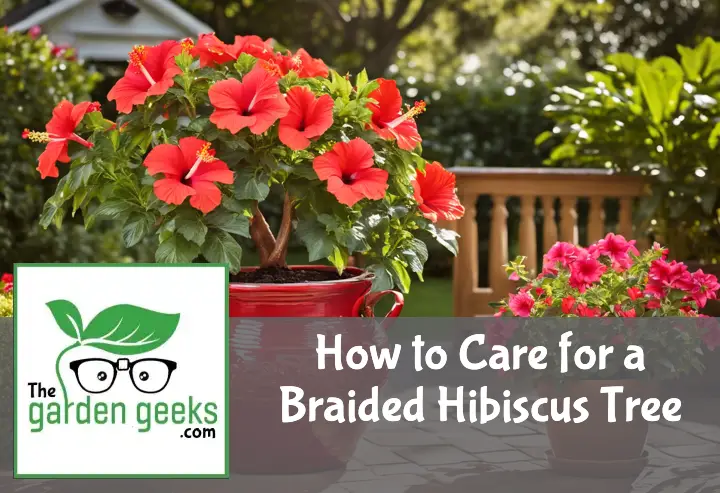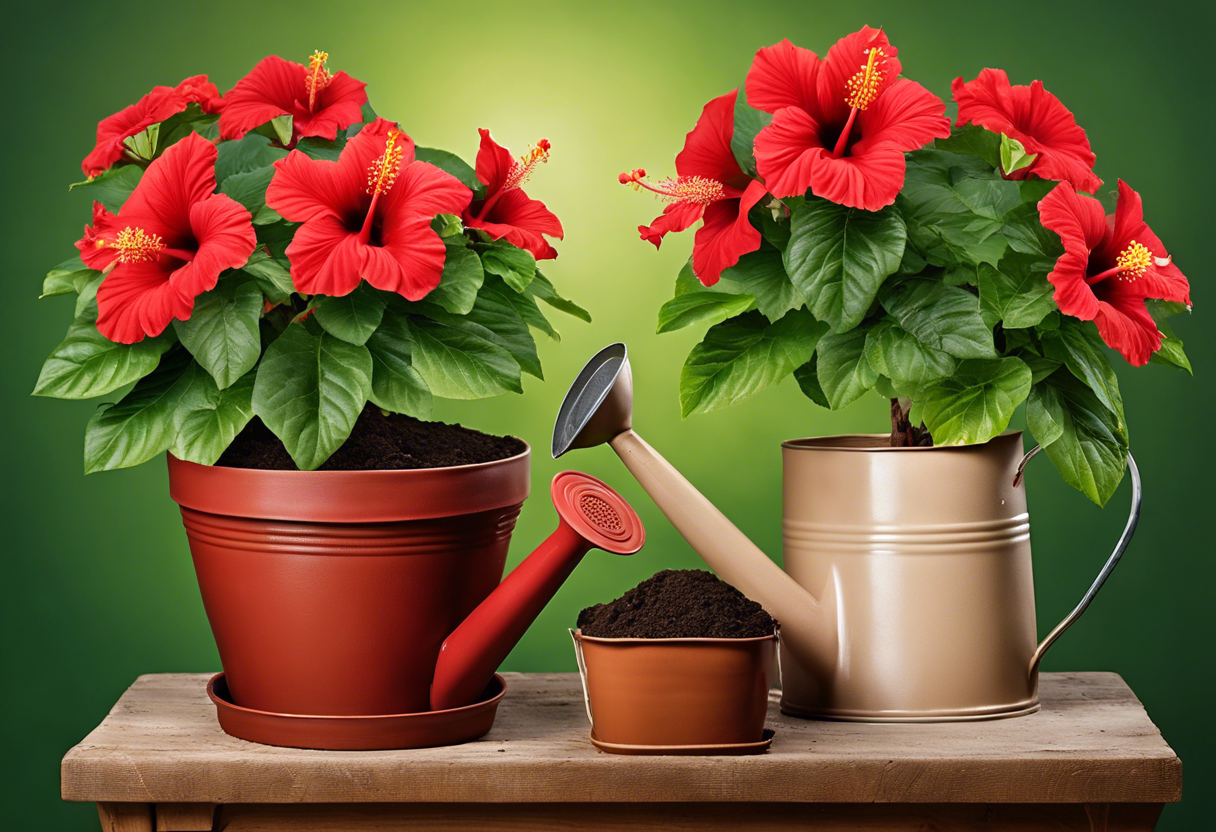Ever heard of a plant that’s not just pretty but also has a cool hairstyle? Yep, you read it right. I’m talking about the Braided Hibiscus Tree. This hipster of the plant world is a stunner, with its vibrant flowers and braided trunk. But how do you keep this beauty blooming?
Well, darling, caring for a Braided Hibiscus Tree isn’t rocket science. It’s all about giving it the TLC it deserves – the right amount of sunlight, water, and food (fertilizer). And voila! You’ll have a flourishing tree that’s the envy of your neighborhood. So, ready to learn How to Care for a Braided Hibiscus Tree? Let’s dive in!
Key Takeaways
- Braided hibiscus trees require full sun exposure and well-drained soil.
- Water the tree deeply but infrequently, allowing the top inch of soil to dry between waterings.
- Fertilize every two weeks during growing season with a balanced plant food.
- Prune in early spring to maintain shape and promote blooming.
- Protect from frost and pests like aphids and whiteflies. Regularly inspect for signs of disease or infestation.
What is a Braided Hibiscus Tree?
Well, folks, let me tell ya, a Braided Hibiscus Tree ain’t your regular run-of-the-mill plant. It’s a bit of an exhibitionist, showing off its vibrant colors and unique shape. No wonder it’s one of the most popular garden plants out there!
Origin and Characteristics
This tropical beauty hails from Asia and the Pacific islands. The origin of Braided Hibiscus is as colorful as its blooms. Now, when it comes to the characteristics of the Hibiscus tree, we’re talking large, trumpet-shaped flowers in a rainbow of colors.
Its growth habit? Well, this isn’t some shrinking violet. The growth habits of Hibiscus include fast growth and a love for sunshine. And the appearance? Picture this: A tall stem with glossy leaves braided together to form a trunk – hence the name, Appearance of Braided Hibiscus.
Different Varieties of Braided Hibiscus Trees
Now onto the fun part – different varieties of Braided Hibiscus! Each has its own personality and style. Some flaunt bold red blooms while others sport delicate pink petals.
The ‘Red Hot’ variety? It’s like the life of the party with its fiery red flowers! Then there’s ‘Seminole Pink’, all soft and romantic with pastel pink blossoms. Each type has distinctive features that make them stand out among other types of tropical hibiscus trees.
So there you have it folks! That’s your crash course on How to Care for a Braided Hibiscus Tree. Stay tuned for more tips on keeping these beauties happy and healthy!
How to Plant a Braided Hibiscus Tree?
So, you’re ready to plant your own Braided Hibiscus Tree, huh? Well, let’s get down to the nitty-gritty of it all.
Choosing the Right Location
First things first, location is everything! Your Hibiscus needs plenty of sunlight. So, find a spot where it can soak up at least six hours of sun each day. That’s right, these babies are real sunbathers!
But wait, there’s more! You also need to consider space. These trees aren’t exactly shrinking violets and can grow up to 15 feet tall! So make sure you’ve got enough room for your Hibiscus to spread its branches.
Preparing the Soil
Next up is soil prep. Now this ain’t just any old dirt we’re talking about here. Your Braided Hibiscus Tree needs well-draining soil with a pH level between 6 and 7.5.
And don’t forget about nutrients! These trees are big eaters and need a good mix of compost or organic matter in their diet. So make sure you’re feeding them well!
Planting Process
Alrighty then, now we’re onto the fun part – planting! Start by digging a hole that’s twice as wide and just as deep as the root ball of your tree.
Place your Braided Hibiscus Tree in the hole and backfill with soil until it’s level with the ground surface. Give it a good watering and voila! You’ve successfully planted your very own hibiscus tree.
Remember folks, when it comes to How to Care for a Braided Hibiscus Tree, patience is key! It might take some time for your tree to settle into its new home but trust me, it’ll be worth the wait!
How to Maintain a Healthy Braided Hibiscus Tree?
When it comes to Braided Hibiscus Tree Care, there are three main areas to focus on: watering, fertilizing, and pruning. These Healthy Hibiscus Practices will ensure your tree thrives.
Watering Requirements
Now, let’s talk about Watering Braided Hibiscus. They’re not too picky, but they do like their water. Generally, you should water them once the top inch of soil feels dry. But be careful! Overwatering can lead to root rot and other nasty problems.
If your hibiscus leaves turn yellow or wilt, that’s a sign of overwatering. On the flip side, if they start dropping leaves or the edges get crispy, you might be underwatering.
Fertilizing Needs
Next up is fertilizing. The Best Fertilizer for Hibiscus is one high in potassium and low in phosphorus. You’ll want to apply it every two weeks during the growing season (spring through fall).
But remember, more isn’t always better when it comes to fertilizer! Too much can burn the roots or cause nutrient imbalances.
Pruning Techniques
Finally, we have pruning – an essential part of Maintaining Hibiscus Trees. The Best Time to Prune Hibiscus is late winter or early spring before new growth starts.
Pruning helps shape the tree and encourages more blooms. Just make sure you use sharp tools and make clean cuts just above a leaf node or bud.
How to Handle Common Pests and Diseases?
When it comes to How to Care for a Braided Hibiscus Tree, dealing with pests and diseases is a biggie. It’s like being a plant doctor, but without the white coat! Let’s dive into the nitty-gritty of Braided Hibiscus pests and Hibiscus tree diseases.
Identifying Common Pests
So, you’ve got some uninvited guests munching on your hibiscus? Not cool. The first step in pest control is knowing what you’re up against. Some common Hibiscus pests include aphids, whiteflies, and spider mites.
Aphids are tiny green or black bugs that suck sap from your plant. Whiteflies look like small white moths and they also love sap. Spider mites? They’re so tiny you might need a magnifying glass! They cause yellow spots or stippling on leaves.
Treating Pest Infestations
Now onto the fun part – kicking those pests to the curb! For natural methods, try spraying your plant with water to knock off aphids or use insecticidal soap for those stubborn mites and whiteflies.
If things get really bad, you might have to bring out the big guns – chemical treatments. Always remember to follow the instructions on the label when using chemical treatments for Hibiscus pests.
Recognizing Signs of Disease
Disease can sneak up on your hibiscus like a ninja in the night. But don’t worry, there are signs you can look out for. Yellowing leaves could mean a nutrient deficiency or root rot while wilting might indicate bacterial wilt.
Look out for spots too! Black spots could be a fungal infection while brown or tan ones might mean bacterial leaf spot. Keep an eye out for these symptoms of diseased hibiscuses and you’ll be one step ahead.
Implementing Disease Control Measures
Prevention is better than cure, right? To prevent diseases in your hibiscus, make sure it’s getting the right amount of water and nutrients. Overwatering can lead to root rot while nutrient deficiencies can weaken your plant.
If a disease does strike, remove affected parts of the plant to stop it spreading. For fungal infections, try a fungicide. Remember, reactive disease control for Hibiscus should be your last resort. Keep your plant healthy and happy to avoid problems in the first place!
How to Prepare Your Braided Hibiscus for Different Seasons?
Seasonal care is crucial when it comes to How to Care for a Braided Hibiscus Tree. Winter and summer, each season demands a unique approach. You see, your braided hibiscus tree maintenance isn’t a one-size-fits-all kind of deal. It’s more like a tailored suit, fitting perfectly with the changing seasons.
Winter Care Tips
When winter rolls in, it’s time to switch gears and focus on winterizing braided hibiscus. The cold can be brutal on these tropical beauties. So, you’ll need to provide some extra TLC to keep them happy.
First off, consider bringing your plant indoors if possible. This is part of indoor hibiscus care in winter, protecting it from the harsh cold outside. But remember, they still need plenty of light so find a sunny spot indoors.
Next up is maintaining the right temperature and humidity levels. These plants are not fans of dry air or freezing temperatures. So, keep them cozy and hydrated throughout the winter months.
Summer Care Tips
Now let’s talk about summer – that sizzling season when your hibiscus needs a different kind of attention. This is where summer care for braided hibiscus comes into play.
Watering becomes crucial during this time as the heat can quickly dry out the soil. So make sure you’re giving your plant enough H2O but avoid overwatering too! It’s all about balance here folks!
Sun exposure is another key factor during summer months. While these plants love sunlight, too much direct sun can cause damage. So find a nice shady spot where your hibiscus can enjoy some rays without getting sunburned.
Remember folks, whether it’s winter or summer, knowing how to prepare your hibiscus for the seasons is an essential part of maintaining hibiscus in summer and winter. So keep these tips in mind, and your braided hibiscus will thank you!
To Wrap Up
Caring for a Braided Hibiscus Tree is like throwing the best party for your plant pal – it’s all about the right mix of sun, soil, water, and love. Keep those green thumbs up and continue to nurture your leafy friend.
For more tips on How to Care for a Braided Hibiscus Tree, don’t be shy! Dive in and explore. Happy planting!



